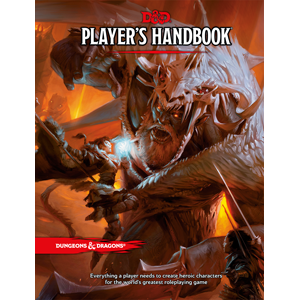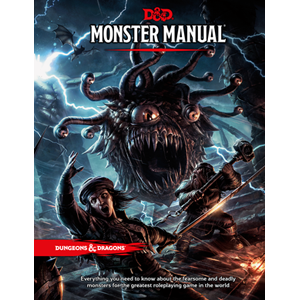Welcome to Purple Pawn, covering games played around the world by billions of people every day.


With Tuesday’s official release of the new Monster Manual, I thought now would be a good time to examine what the fifth edition of Dungeons & Dragons offers to new and established gamers. The last of D&D’s traditional three-piece core rulebook set, the Dungeon Master’s Guide, has been delayed until December 9th. However, between the Monster Manual and Player’s Handbook (and with the aid of the free Basic Rules) there’s more than enough to get started playing a game.
Overall this fifth edition of Dungeons & Dragons is a fine entry in the game’s long legacy. Of course the first two books cover all the essential rules for running a traditional fantasy roleplaying game. The Player’s Handbook focuses on making and developing characters but also includes sections that explain the basic concepts of roleplaying, how and when to roll dice, what can be accomplished with different character abilities, how to resolve fights with monsters, and what it means to cast a spell. The Monster Manual catalogs hundreds of fantastic and terrifying creatures, many normal animals, and a nice selection of typical antagonists (bandits, priests, guards, etc.).
The books go beyond the essentials, however, presenting Dungeons & Dragons in a way that emphasizes the adventure and storytelling at the heart of the game. It’s an approach—a philosophy—that’s integral to the mechanics, options, and other material. Character backgrounds and ideals, inspiration, non-combat feats, advantage and disadvantage, equipment proficiencies, and lair actions are all rules that contribute to this focus. Even the creature descriptions in the Monster Manual share in this approach. Instead of field-guide-style, entries focus on what’s unique, special, or legendary about each monster.
For seasoned roleplaying gamers, no doubt there are things to quibble with, both mechanically and presentation-wise. For example, I’m not a fan of perception, investigation, and insight skills. Others have pointed out the obvious lack of a monster-by-challenge-rating list (though that is now available online). But in general, fifth edition Dungeons & Dragons appears to be a solid game—one with a consistent design philosophy that’s clearly rooted in old school but informed by modern experience. My best short description for those who know their way around RPGs is: “AD&D, fixed.”
For newbies, Dungeons & Dragons fifth edition presents a nice balance of modernity and tradition, of simplicity and detail, of rules and inspiration, of storytelling and game. It’s not that the new D&D is the best game around—there are others just as good in the market, maybe even others better suited to particular players. Most groups, however, will be well-served by Fifth’s quality mainstream roleplaying experience.
Copies of the Player’s Handbook and Monster Manual were provided free for review by Wizards of the Coast.
No Comments
Sorry, the comment form is closed at this time.
Trending
- Massdrop.com
- Oh the Irony—Illuminati Card Game Continues to Inspire Conspiracy Theorists
- Footprints, an Educational Ecology Game
- Home
- USPS Adds Board Game Flat Rate Box
- Baila, the Estonian Drinking Card Game
- Crystal Caste Wins Dice Patent Suit Against Hasbro
- Mirror Game, Red and Blue
- Are Board Games Dangerous?
- Board Games Based on Hindu Mythology
Archives
Most Popular Articles
- Oh the Irony—Illuminati Card Game Continues to Inspire Conspiracy Theorists
- The 20 Most Valuable Vintage Board Games
- The Truth About Dominoes On Sunday in Alabama
- Sequence Game, and Variants
- USPS Adds Board Game Flat Rate Box
- Baila, the Estonian Drinking Card Game
- The 13 Most Popular Dice Games
- Are Board Games Dangerous?
- Guess Who? The Naked Version
- What Happened to the Jewel Royale Chess Set?
Recent Posts
- Toy Fair 2019—Breaking Games
- Talisman Kingdom Hearts Edition
- Toy Fair 2019—Winning Moves
- Toy Fair 2019—Games Workshop
- Toy Fair 2019—Star Wars Lightsaber Academy
- Toy Fair 2019—Stranger Things Games
- Toy Fair 2019—HABA
- Licensing Roundup
- Game Bandit
- 2018 A Difficult Year For Hasbro But Not For D&D Or MtG
Recent Comments
- on Toy Fair 2019—Winning Moves
- on Game Bandit
- on Second Look—Dungeons & Dragons Waterdeep Dragon Heist
- on Crowdfunding Highlights
- on Beyblade SlingShock
- on Game Bandit
- on Game Bandit
- on Watch This Game!, the Board Game Review Board Game
- on Second Look—Vampire: The Masquerade 5th Edition
- on Palladium Books Loses Robotech IP License, Cancels Five-Year-Overdue Robotech RPG Tactics Kickstarter




